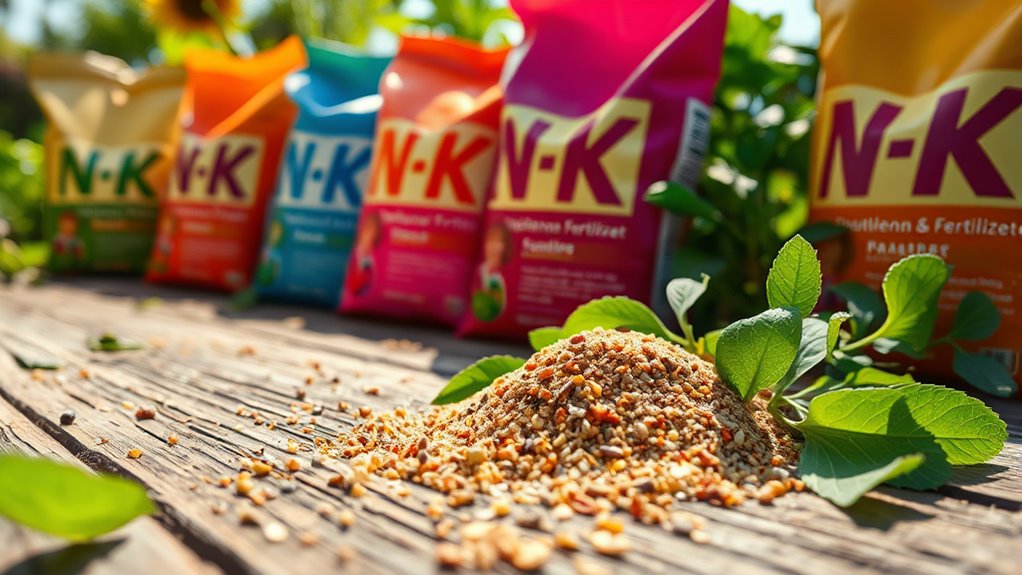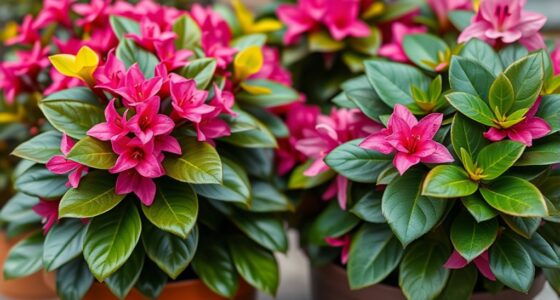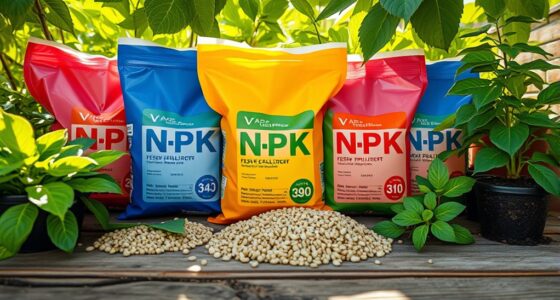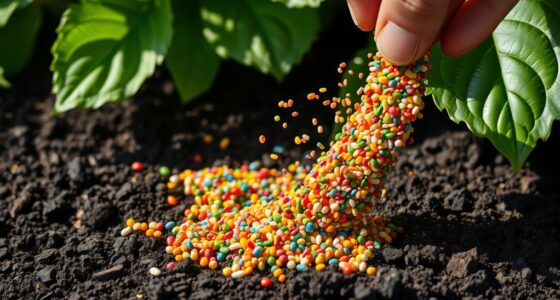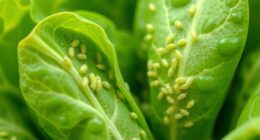Fertilizer 101 starts with understanding N-P-K ratios, which represent nitrogen, phosphorus, and potassium—the three main nutrients plants need. Nitrogen promotes leafy growth, phosphorus supports roots and flowers, and potassium boosts overall strength and fruit quality. Matching these ratios to your plants’ specific needs helps prevent deficiencies and encourages healthy growth. To learn how to choose the right mix and keep your garden thriving, keep exploring what your plants really need.
Key Takeaways
- The N-P-K ratio indicates the levels of nitrogen, phosphorus, and potassium in fertilizer, essential for different plant growth stages.
- Nitrogen promotes leafy, green growth; phosphorus supports root development and flowering; potassium boosts overall plant resilience.
- Match fertilizer N-P-K ratios to your plants’ specific needs to prevent deficiencies and optimize growth.
- Organic fertilizers release nutrients slowly, improving soil health and reducing environmental impact, unlike quick-acting synthetic options.
- Testing soil helps determine nutrient deficiencies, allowing targeted organic amendments like compost, bone meal, or fish emulsion.

Ever wondered how to give your plants the nutrients they need to thrive? The secret lies in understanding the foundation of healthy plant growth: soil health. Healthy soil isn’t just dirt; it’s a living ecosystem teeming with microorganisms, organic matter, and nutrients. When you focus on improving soil health, you create an environment where plants can absorb essential nutrients more effectively. Incorporating organic nutrients into your soil boosts this natural process, providing your plants with the nutrients they need without relying solely on synthetic fertilizers. Organic nutrients, like compost, manure, or plant teas, enrich the soil with beneficial microbes and organic matter, promoting long-term soil vitality. This approach not only supports plant growth but also enhances soil structure, moisture retention, and microbial activity, making your garden more resilient over time. Additionally, understanding Free Floating concepts can help you optimize your garden’s overall health and productivity.
Understanding what your plants need starts with recognizing the importance of the N-P-K ratio, which represents the three primary nutrients: nitrogen (N), phosphorus (P), and potassium (K). These nutrients serve distinct roles in plant development. Nitrogen is essential for lush, green leafy growth, making it indispensable for vegetables like lettuce and spinach. Phosphorus encourages strong root development and flowering, indispensable for fruiting plants like tomatoes and peppers. Potassium helps plants resist diseases, improves overall vigor, and enhances fruit quality. When choosing a fertilizer, it’s important to match the N-P-K ratio to your plants’ specific needs, as an imbalance can lead to poor growth or nutrient deficiencies.
Fertilizer options vary from synthetic to organic, but many gardeners prefer organic fertilizers because they work with your soil’s natural processes. Organic nutrients release slowly, providing a steady supply of essential elements while maintaining soil health. This slow release prevents nutrient runoff and reduces environmental impact. You can also tailor organic amendments to target specific deficiencies; for example, fish emulsion supplies nitrogen, bone meal offers phosphorus, and wood ash provides potassium. By understanding your soil’s current nutrient levels—often through soil testing—you can add the right organic nutrients to correct deficiencies and support sustainable growth.
In essence, giving your plants the right nutrients involves more than just tossing fertilizer into the soil. It’s about nurturing soil health with organic nutrients that work harmoniously with your garden’s ecosystem. This approach fosters stronger, healthier plants that are more resistant to pests and diseases, producing more bountiful harvests in the long run. When you prioritize soil health and choose organic nutrients tailored to your plants’ needs, you set the stage for a thriving garden that’s both productive and environmentally friendly.
Frequently Asked Questions
How Do I Choose the Right Fertilizer for My Specific Plants?
To select the right fertilizer for your plants, start with soil testing to determine its nutrient levels. This helps you understand your plants’ specific nutrient needs and avoid over or under-fertilizing. Look for a fertilizer with the appropriate N-P-K ratio that matches your plants’ requirements. By matching fertilizer to soil conditions and plant needs, you ensure healthy growth and vibrant blooms, making your gardening efforts more successful.
Can Over-Fertilizing Harm My Plants or the Environment?
Over-fertilizing can definitely harm your plants and the environment. When you give too much fertilizer, it can cause soil contamination and nutrient runoff, which pollutes nearby water sources. Excess nutrients can lead to root damage, stunted growth, or even plant death. Plus, runoff carries fertilizers into lakes and rivers, harming aquatic life. To avoid these issues, follow recommended application rates and use slow-release fertilizers when possible.
Are Organic Fertilizers as Effective as Chemical Ones?
You might wonder if organic fertilizers are as effective as chemical ones. Organic benefits include improving soil health, promoting beneficial microbes, and reducing chemical drawbacks like runoff and pollution. While chemical fertilizers provide quick nutrient boosts, they can harm the environment and soil over time. If you want sustainable growth, using organic fertilizers can be just as effective, especially for long-term plant health and soil vigor.
How Often Should I Fertilize Different Types of Plants?
You should fertilize your plants based on their specific needs, which varies by type. Generally, flowering plants need weekly feeding, while vegetables benefit from biweekly fertilizing. Adjust your watering schedule to help nutrients absorb, and always watch for signs of over-fertilizing or pests. Proper pest control can also enhance nutrient uptake, so stay vigilant. Regular fertilization, tailored to each plant, keeps them healthy and thriving.
What Are Signs My Plants Are Lacking Nutrients?
You might notice leaf discoloration or stunted growth if your plants lack nutrients. Yellowing leaves often indicate nitrogen deficiency, while poor development or small leaves suggest other nutrient shortages. Keep an eye on these signs, and if you see them, consider adjusting your fertilization routine. Providing the right balance of nutrients helps your plants thrive and prevents issues caused by nutrient deficiencies.
Conclusion
Now that you understand the dance of N-P-K, your plants are ready to flourish like a well-tuned orchestra. Think of fertilizers as the secret recipe, revealing vibrant growth and lush leaves. With each application, you’re planting the seeds of a thriving garden, turning dirt into a canvas of life’s masterpiece. Trust your knowledge, and watch your green world bloom with the confidence of a gardener who truly understands the language of nutrients.
